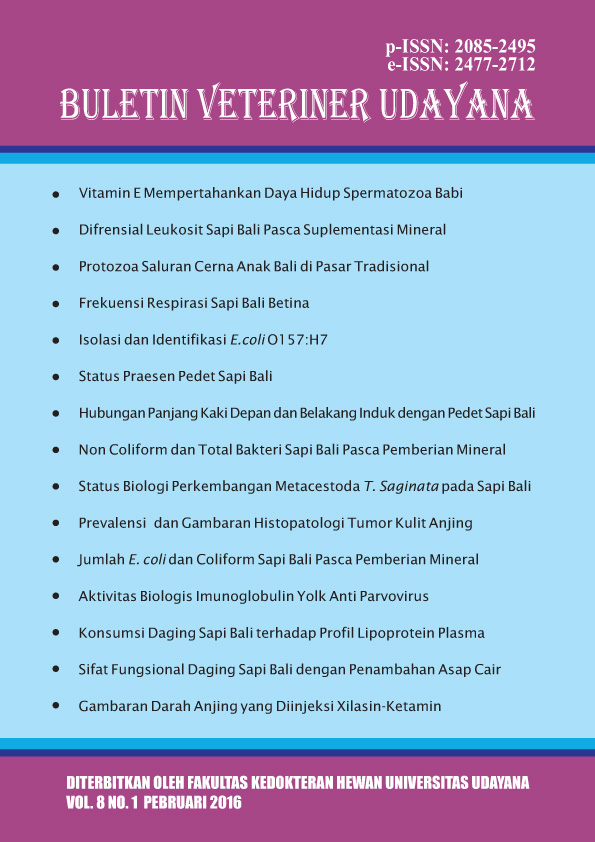ISOLATION AND IDENTIFICATION OF ESCHERICHIA COLI O157:H7 IN CATTLE STOOL AT PETANG SUBDISTRICT, BADUNG REGENCY-BALI
Abstract
Coliform are commonly found in livestock stool, including cattles and Escherichia coli (E. coli) is one of the most popular of Coliform groups. Various strains of E. coli are pathogenic which oneof them is serotype O157:H7 which known producing Shiga like toxin. The study initiated by collecting 58 samples of fresh cattle stool which were taken from seven villages in the district of Petang, followed by isolating and identificating of strain. The results of study presented indescriptive and the relationship between each vaiable was analyzed by Spearman 's rho and McNemar test. Among 58 samples, all of them were positive Coliform (100 %), and 29 samples positive E. coli (50 %). Among E. coli positive, that were found 7 samples were positive E. coli O157 ( 12.07% ) and 5 samples positive E. coli O157:H7 (8.62 %). The total Coliform and the number of E. coliwere highly significant difference, while the number of E. coli O157 and E. coli O157:H7 were not significant difference. Coliform bacteria in the stool of cattle could not be used as a predictable factor for the presence of E. coli, E. coli O157 and E. coli O157:H7, but the presence of E. coli would be enable to predict the presence of E. coli O157 as well as E. coli O157:H7. Futhermore, the study also showed the presence of E. coli O157 was as a good predictor to the presence of zoonotic agents E. coli O157:H7.
Downloads
References
Badan Pusat Statistik Kabupaten Badung. 2013. Kecamatan Petang dalam angka 2013. http://badungkab.bps. go.id/kecamatan_dalam_angka/2013/petang. Tanggal Akses 13 Mei 2014.
Bambang GA, Fatimalawi, Kojong NS, 2014. Analisis Cemaran Bakteri Coliform dan Identifikasi Escherichia coli pada Air Isi Ulang dari Depot di Kota Manado. J Ilmiah Farmasi. 3(3): 325-334.
Bettelheim KA, 2000. The role of non-O157 VTEC. J of Applied Microbiology Symposium Supp. 88: 38S-50S.
Brusa V, Aliverti V, Aliverti F, Ortega, EE, de la Torre JH, Linares LH, 2013. Shiga toxin producing Escherichia coli in beef retail markets from Argentina. Front Cell Infect Microbiol 2: (171).
Chaudhuri RR, and Henderson IR, 2012. The evolution of the Escherichia coli phylogeny. Infect. Genet. Evol. Rev. (Article in press).
Hanif SKS, Sumiarto B, Budiharta S, 2003. Pravalence and Analysis Of Escherichia coli O157:H7 Infection Factors in Small Holder Dairy Cows in The District of Sleman. J.Sain Vet. 20 (1): 51.
Karmali MA, Gannon V, Sargeant JM, 2010. Verocytotoxin-producing Escherichia coli (VTEC). Vet Microbiol; 140(3-4): 360-370.
Mahon CR, and Manuselis G, 2000. Texbook of diagnostic microbiology. 2ndEd. Saunders.
Martin SW, Meek AH Willeberg P, 1987. Veterinary epidemiology principles and methods. Lowa States University Press. Lowa. 23-40.
Page AV, and Liles WC, 2013. Enterohemorrhagic Escherichia coli Infections and the Hemolytic Uremic Syndrome. Med Clin North Am 2013; 97(4): 681-95.
Steel RGD, dan Torrie JH, 1995. Prinsip dan Prosedur Statistika. PT Gramedia Pustaka. Jakarta.
Stenutz R, Weintraub A, Widmalm G, 2006. The structure of Escherichia coli O-polysaccaride antigens. FEMS microbiology. 30 (3): 382–403.
Suardana IWA, Ratnawati B, Sumiarto, Lukman DW, 2008. Deteksi keterkaitan keberadaan coliform, E. coli, dengan keberadaan agen zoonosis E. coli O157 dan E. coli O157:H7 pada feses manusia di Kabupaten Badung Provinsi Bali. Medicina. 39(3): 216-218.
Suardana IW, Pinatih KJP, Ratnawati NLKA, Widiasih DA, 2013. Protein
Profile Analysis of Escherichia coli O157:H7 from Human and Animals Origin. Int J Curr Microbiol Appl Sci.; 2: 204-14.
Suardana IW, Utama IH, dan Wibowo BMH, 2014a. Identifikasi Escherichia coli O157:H7 dari Feses Ayam dan Uji Profil Hemolisisnya Pada Media Agar Darah. Jurnal kedokteran hewan. 8(1): 1-5.
Suardana IW, 2014b. Analysis of Nucleotide Sequences of the 16S rRNA Gene of novel Escherichia coli strains isolated from feces of human and Bali cattle. J Nucleic Acids doi: 10.1155/2014/475754.
Wani SA, Samanta I, Munshi ZH, Bhat MA, and Nishikawa Y, 2004. Shiga toxin-producing E. coli and Enteropathogenic E. coli in healthy goats in India: Occurrence and Virulence Properties. J. Appl. Microbiol. 100:108–11





